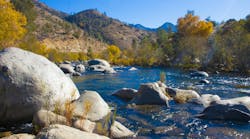Heat Wave
The National Oceanic and Atmospheric Administration’s (NOAA) Arctic Research Program released its annual Arctic Report Card at the American Geophysical Union meeting in San Francisco Dec. 13. I have to admit, writing about long-term warming trends in the Arctic feels a little strange as we’ve just entered the season of below-zero wind chills here in Chicago, but when the scientists speak, I'm willing to listen.
The report card is the work of 61 scientists from 11 countries. The lengthy document outlines, among other things, temperature trends and ice melt in the Arctic. Key takeaways from this year’s study indicate that the average surface air temperature for the year ending September 2016 was the highest since 1900, and four months of 2016 reported record monthly highs.
“Rarely have we seen the Arctic show a clearer, stronger or more pronounced signal of persistent warming and its cascading effects on the environment than this year,” said Jeremy Mathis, director of NOAA’s Arctic Research Program in a news release. “While the science is becoming clearer, we need to improve and extend sustained observations of the Arctic that can inform sound decisions on environmental health and food security as well as emerging opportunities for commerce.”
So what does this mean for those of us not in the Arctic? In plain terms, Arctic ice melt, combined with other environmental factors, leads to global sea level rise. Currently, the rising arctic temperatures are expected to impact the coasts of Russia, Alaska, and Canada, and accelerate the melting of the Greenland ice sheet, according to National Geographic.
These environmental changes won’t happen overnight, but as the New York Times reports, our coastal communities are already feeling the effects. High tides are shrinking beaches and creating more frequent tidal floods in coastal communities. This means the storm water and erosion control industry will have to amp up flood control and prevention measures to deal with the increased influx of water, exacerbated by rain events. This extra work will require extra money, which will require support from local and federal governments.
The more severe effects of global sea level rise likely will not impact most of us in our lifetimes, but investments should be made now to mitigate the potentially devastating effects in the future.


